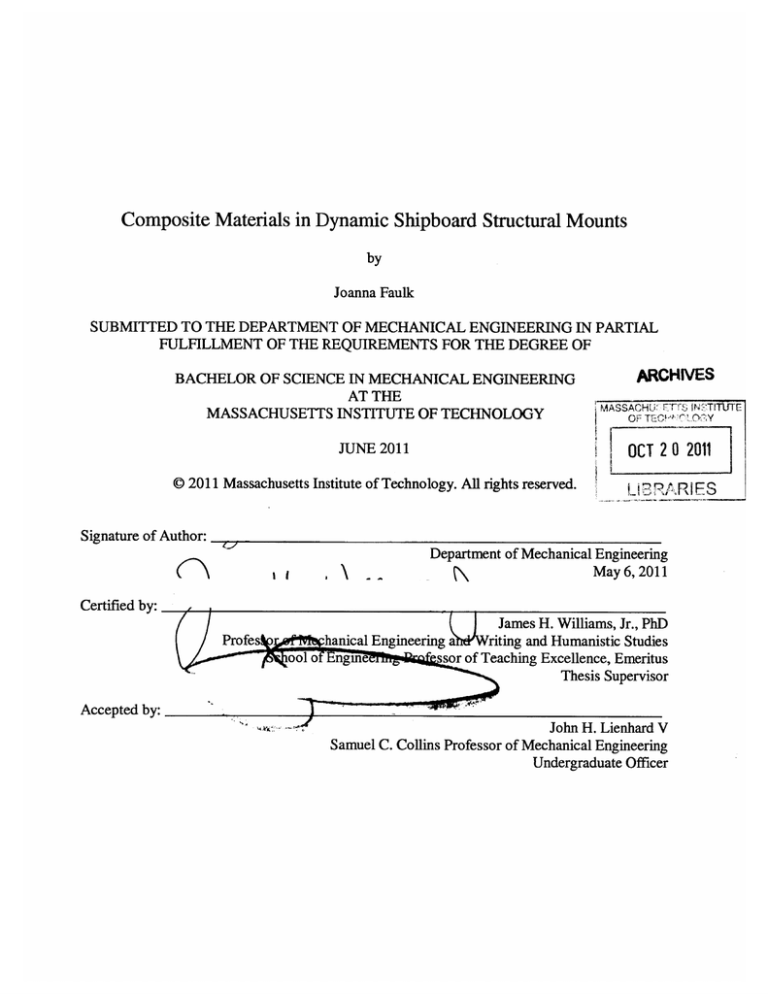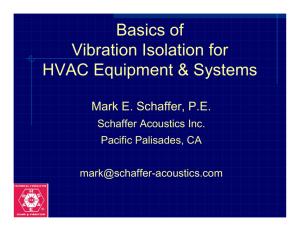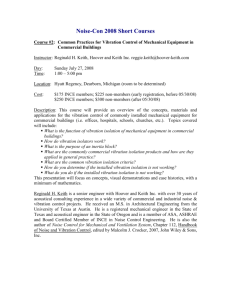
Composite Materials in Dynamic Shipboard Structural Mounts
by
Joanna Faulk
SUBMITTED TO THE DEPARTMENT OF MECHANICAL ENGINEERING IN PARTIAL
FULFILLMENT OF THE REQUIREMENTS FOR THE DEGREE OF
BACHELOR OF SCIENCE IN MECHANICAL ENGINEERING
AT THE
MASSACHUSETTS INSTITUTE OF TECHNOLOGY
ARCHIVES
MASSACKH-ilFTI .
TITUTE
JUNE 2011
OCT 2 0 2011
(@2011 Massachusetts Institute of Technology. All rights reserved.
L B1RA R IES
Signature of Author:
Gn
I I
Department of Mechanical Engineering
May 6, 2011
Certified by:.
James H. Williams, Jr., PhD
ing alrdWriting and Humanistic Studies
sr of Teaching Excellence, Emeritus
Thesis Supervisor
Accepted by:
John H. Lienhard V
Samuel C. Collins Professor of Mechanical Engineering
Undergraduate Officer
Composite Materials in Dynamic Shipboard Structural Mounts
by
Joanna Faulk
Submitted to the Department of Mechanical Engineering
On May 6, 2011 in Partial Fulfillment of the
Requirements for the Degree of Bachelor of Science in
Mechanical Engineering
ABSTRACT
The purpose of this thesis is to investigate the viability of replacing traditional metal structural
and machinery mounts with padding made of composite material. The two types of padding or
isolation materials are represented by steel and CFRP (carbon fiber reinforced polymer).
Machinery and instruments in ships are often mounted for two main reasons: they create
unwanted vibrations and they need to be isolated from shock and external vibration. In order to
analyze this problem, the machinery or instrument plus its padding are modeled as a massspring-damper system. The results show that CFRP generally works better for vibration
isolation, while steel works better for shock isolation.
Thesis Supervisor:
Titles:
James H. Williams, Jr., PhD
Professor of Mechanical Engineering and Writing and Humanistic Studies
School of Engineering Professor of Teaching Excellence, Emeritus
Acknowledgements
The author would like to show appreciation to the following people for their contributions in the
completion of this thesis:
Professor James H. Williams, Jr., thesis advisor, for his mentoring and guidance.
Anna Haas, David Hawes, and Rachel Lewis, for their assistance in research and
computations.
Cedrick and Joanne Faulk, for their continued love and support.
The author is also grateful for the financial contribution of the DDG-1000 Program Manager
(NAVSEA PMS 500) and the technical guidance of the DDG-1000 Ship Design Manager
(NAVSEA 05D).
Table of Contents
Abstract
2
List of Figures
5
List of Tables
6
1.
2.
3.
4.
Introduction
7
1.1
Background and Motivation
7
1.2
Vibration and Shock
7
1.3
Transmissibility and Isolation
8
1.4
Overall Approach
9
Theoretical Analysis
9
2.1
Mass-Spring-Damper Model
9
2.2
Governing Equations
10
2.3
Computer Simulation
12
Results and Discussion
13
3.1
Impulse
14
3.2
Transmissibility
15
Conclusion
17
4.1
General Trends
17
4.2
Future Recommendations
17
References
18
List of Figures
Figure 1: Graphs representing vibration (left) and shock (right).
8
Figure 2: Picture depicting the difference between transmissibility (left) and isolation (right).
9
Figure 3: Picture showing the replacement of the isolator padding (left) with a theoretical spring
and damper (right).
10
Figure 4: Graph of the amplitude of oscillations of the ECDIS (ship navigation system) as
function of time for two possible isolator pads.
14
Figure 5: Graph of the amplitude of oscillations of the marine diesel engine as function of time
for two possible isolator pads.
15
Figure 6: Graph of the transmissibility provided by each of the two possible isolator pads for the
ECDIS (ship navigation system) as a function of the normalized frequency.
16
Figure 7: Graph of the transmissibility provided by each of the two possible isolator pads for the
marine diesel engine as a function of the normalized frequency.
16
List of Tables
Table 1: Marine Diesel Engine and Electronic Chart Display Information System (ECDIS)
13
parameters.
Table 2: Properties of Steel and Carbon Fiber Reinforced Polymer (CFRP).
13
1.
Introduction
1.1
Background and Motivation
In electric ships, there are many rotating/oscillating components where vibration is
generated and also many sensitive components that need to be isolated from these vibrations.
Vibrations within the ship can cause other problems as well. Machinery, instruments, mounts, or
even the ship itself can be damaged. These vibrations can also spread to the ocean, making the
ship more perceivable by detection devices. Presently, different metals (i.e., steel) are utilized in
the structural and machinery mounts. The assessment in this paper explores the possibility of
replacing these mounts with composite materials. A composite material is made by physically
combining two or more materials encompassing different properties; however, the materials are
not combined chemically. Composites may be less stiff than most metals, but they generally are
lighter and combine compressive with tensile strength, giving composites a greater appeal. They
also tend to be less susceptible to corrosion, making them especially valuable for use in ships
where salt water may cause damage in metals.
1.2
Vibration and Shock
This section details the different types of unwanted sound, also known as noise, that are
desired to not be transmitted: vibration and shock.
Mechanical vibration is defined as the
oscillation of an object about a central, equilibrium position. A simple example of this type of
oscillation is a mass on an extension spring. In the case that the mass displaced to a point above
its rest position, the force of gravity causes the mass to accelerate downward. The restoring
force of the spring then pulls the mass back up, and then the cycle repeats. If the mass is first
displaced to a point below the equilibrium position, the same steps occur, with the restoring force
acting first. This cycle would continue in an ideal situation, but due to the addition of friction
and other damping forces, the magnitude of these vibrations decreases until finally the mass no
longer moves at all.
Shock is different than vibration, in that it is caused by one single force. The duration of
the force is often very short, and the magnitude is very large.
Figure 1 below shows the
difference between vibration and shock, both of which are explored as possible disturbances to
the system.
-0.5 -
-0.5-
0
2
4
6
8
10
0
2
4
6
8
10
Figure 1: Graphs representing vibration (left) and shock (right).
1.3
Transmissibility and Isolation
When dealing with vibrations, it is important to know the difference between
transmissibility and isolation. Transmissibility is associated with preventing the vibrations from
a mass from spreading to the base, while isolation involves preventing external vibrations from
affecting the mass. Figure 2 below shows this difference.
Mass I
Spring
Mass
Spring
Damper
Damper
Figure 2: Picture depicting the difference between transmissibility (left) and
isolation (right).
1.4
Overall Approach
For this thesis, different instruments and machinery that are relevant to this type of
vibration on a ship are researched.
A list of these different items is compiled, and the
components most worthy of being noted are investigated. The system is modeled as a massspring-damper system, to which engineering mechanics equations are applied. Calculations are
done to measure the degree of isolation that composite and traditional materials can provide.
Using the data visualization properties of the computer program MATLAB, graphs are provided
comparing the efficiency of isolation of composites to traditional materials. The main objective
of an isolator system is to diminish the noise created as quickly as possible, which is the criterion
of deciding the best material to use for the isolator.
2.
Theoretical Analysis
2.1
Mass-Spring-Damper Model
In order to examine the behavior of the system, it is approximated with a mass-spring-
damper model, depicted in figure 3 below.
The mass represents whatever object would be
mounted on the ship, either machinery or an instrument. The spring and damper represent either
the composite material padding or the metal structural mount, also known as the isolation
system. The base represents the floor, ceiling, or other wall of the ship.
Mass
Spring
Damper
Isolator Mass
Padd g7--4-Figure 3: Picture showing the replacement of the isolator padding (left) with a
theoretical spring and damper (right).
The causes of noise disturbances can be natural or artificial. Natural causes include
waves, land, or even sea creatures. These natural disturbances are almost always a result of
shock.
Vibrations are usually caused by machinery within the ship itself. These types of
disturbances are artificial.
2.2
Governing Equations
This section details the different equations input into MATLAB in order to produce the
graphical results that will be discussed later in the paper. As previously stated, the isolation
system will be modeled as mass-spring-damper system. The first equation comes from the study
of Young's modulus, E, in engineering mechanics.
Young's modulus is the comparison of
tensile stress, a, to tensile strain, s. Tensile stress is represented as the force, F, applied to an
object divided by the cross-sectional area, Ao, through which the force is applied. Tensile strain,
on the other hand is represented as the change in length, AL, divided by the original length, Lo.
Equation 1 below shows the aforementioned relationships.
10
Equation 1
stress a
F/AO
- = -=
E=
strain E AL/Lo
Equation 1 can now be rearranged to define the force exerted on the object, shown in
equation 2. This force is comparable to the restoring force of a spring, which is defined as the
product of the spring constant, k, and its displacement, x. This relation is known as Hooke's law,
shown in equation 3.By equating the two forces, and realizing that AL and x denote the same
quantity, the spring constant equivalent for any material, given the Young's modulus, area, and
length, can be found. Equation 4 defines this new spring constant equivalent, in which L is the
thickness of the isolator padding.
Equation 2
F=
-
\A
L0 /
AL
Equation 3
F = -kx
Equation 4
EA
k= -
L
Another important aspect of this model is accurately modeling the effective mass, Meff,
which is defined for a spring as the mass of the object attached to the spring, Mobj, added to a
fraction of the spring mass, which in this case is actually the mass of the isolator pad, Miso.
Although, there is some variability in the value of this fraction, a value of one-third is chosen in
order to model the padding as a stiff spring. This relation is shown in equation 5 below.
Equation 5
Meff =
{
+ Mobj
In order to properly model the motion of the system, there are still two more parameters
needed, co., the natural frequency, and c, the damping coefficient. The natural frequency is the
11
same as the un-damped frequency, while the damping coefficient represents the energy
dissipated. Both of these values depend on the spring constant and effective mass, as shown in
equations 6 and 7. The damping coefficient also depends on F, the damping ratio, a scaling
factor describing how the oscillations decay over time. The damping ratio was chosen arbitrarily
at 0.3, a commonly used value.
Equation 6
k
_
Meff
Equation 7
c = 24
kMeff
With the aforementioned equations, the equation of motion, shown in two different
versions in equation 8 below, is able to be completely defined for the system.
For more
information on how these equations were derived, please refer to the Williams and Hawes paper
reported in the references section.
Equation 8
i+2awnk+wonx =mzid+c*+kx =0
2.3
Computer Simulation
The computer application MATLAB is used to create a graphical interpretation of the
data.
Two different types of objects are used.
The marine diesel engine, which creates
vibrations itself, most commonly needs a system designed to increase transmissibility.
The
Electronic Chart Display and Information System (ECDIS) is a sensitive instrument that may
require a system with increased isolation capability. These two objects and their parameters are
listed below in table 1.
Table 1: Marine Diesel Engine and Electronic Chart Display Information System
(ECDIS) parameters.
Marine
Diesel
Engine
Electronic Chart Display
Information System
(ECDIS)
Type
Oscillating
Machinery
Sensitive Instrument
Mass
Area of
2000 kg
3m2
200 kg
bottom
2 m2
Two different programs were made with MATLAB. Most objects need protection from
shock, while not all of them will need protection from vibrations. The first program creates a
graph of the position of an object subject to an impulse.
The second program shows the
transmissibility a measure of the efficiency of the isolator system.
For the time being, there are only two materials being used in the MATLAB programs to
analyze the padding. These materials, steel and carbon fiber reinforced polymer (CFRP), are
representative of composite and traditional materials. These materials and their properties are
shown below in table 2.
Table 2: Properties of Steel and Carbon Fiber Reinforced Polymer (CFRP)
CFRP (carbon fiber
Steel
reinforced polymer)
Type
Metal
Composite
3
Density 7,800 kg/m
1,600 kg/m3
Mouns
3.
Results and Discussion
210 GPa
150 GPa
3.1
Impulse
The impulse program represents how quickly motion is dissipated after a shock is
applied. Figures 4 and 5 below show how the system reacts to the ECDIS and the marine diesel
engine, respectively. Steel proves to be better suited for this scenario where shock is involved.
0.025
0.02
0.015
0.01
0.005
L
-0.005 -0.01 0
r
0.5
r
1
r
r
1.5
2
Time (s)
r
2.5
r
3
3.5
x 104
Figure 4: Graph of the amplitude of oscillations of the ECDIS (ship navigation
system) as function of time for two possible isolator pads.
x 10Steel
CFRP
65
4
3
E <1
0
-1
-2-3 -.
0
1
r
2
r
3
Time (s)
r
r-
4
5
6
x 10
Figure 5: Graph of the amplitude of oscillations of the marine diesel engine as
function of time for two possible isolator pads.
3.2
Transmissibility
The second program shows how well the isolator pad prevents the transmission of
vibrations. Figures 6 and 7 below show how steel and CFRP would perform for both the ECDIS
and marine diesel engine. Here the transmissibility is plotted as a function of a normalized
frequency, which is the excitation frequency divided by the natural frequency of the system. The
"better" material is the one whose peak comes first in the plot. Here, steel works better for the
smaller mass of the ECDIS, while CFRP works better for larger masses like the marine diesel
engine.
1.5-
E
C
S1
0.5-
0 -
0
r
0.5
r
r
r
r
r
r
r
1
1.5
2
2.5
3
3.5
4
Excitation Frequency/Natural Frequency of CFRP
r
:
4.5
5
x 10
Figure 6: Graph of the transmissibility provided by each of the two possible
isolator pads for the ECDIS (ship navigation system) as a function of the
normalized frequency.
L
Steel
2
CFRP
1.5 -
E
0.5
00
r
r
0.5
1
1.5
2
Excitation Frequency/Natural Frequency of CFRP
2.5
x 105
Figure 7: Graph of the transmissibility provided by each of the two possible
isolator pads for the marine diesel engine as a function of the normalized
frequency.
4.
Conclusions
4.1
General Trends
As the parameters of the machinery or instrument change, the effectiveness of the
vibration or shock isolation also changes. In the impulse program, increasing the mass and/or
increasing the area of the object causes the gap between steel and CFRP to decrease. This means
that CFRP becomes more efficient at reducing noise due to shock as mass and area increase.
Still, steel is a better choice in the case of shock. In the transmissibility program, increasing the
mass and/or decreasing the area causes CFRP to have a better efficiency, while decreasing the
mass and/or increasing the area results in a better efficiency with steel.
However, most
vibrations are caused by heavy machinery, meaning a higher mass. This means that usually,
CFRP works better for vibration isolation, while steel works better for shock isolation.
4.2
Future Recommendations
For future research into this topic, finding the effects of changing the area and mass of
the object for the different types of disturbances would be very helpful in determining which
material to use on a case-by-case basis. Also, creating an experimental test setup would be
helpful in order to experimentally validate the model presented in this paper. Another possible
area of interest is changing the model to account for a different fraction of the pad mass. Last
but not least, one could add new materials as isolator padding.
References
"Composite Materials." Nova - Science in the News. Australian Academy of Science, Nov. 2000.
Web. May 2011. <http://www.science.org.au/nova/059/059key.htm>.
"ECDIS Basics." Firstenberg.5 Feb. 2011. Web. Apr.-May 2011. <http://www.fuerstenbergdhg.de/index.php?id=ecdisstartseite>.
Krodkiewski, J. M. "Mechanical Vibration." Mechanical Engineering: Melbourne School of
Engineering. University of Melbourne, Australia, 2008. Web. Mar.-May 2011.
<http://www.mech.unimelb.edu.au/dynamics/14ec.pdf>.
Rodriguez, Eduardo E., and Gabriel A. Gesnouin. "Effective Mass of an Oscillating Spring." The
Physics Teacher 45 (2007). Print.
"Technical Section: Vibration and Shock Isolation." Anti Vibration Mounts. Advanced
2011.
Feb.-May
Web.
Components.
Antivibration
<http://www.vibrationmounts.com/V100/V100Cat.htm>.
"Vibration Isolation for Precision Equipment." Herzan - Vibration and Acoustic Isolation. Web.
Mar.-May 2011. <http://www.herzan.com/herz1.htm>.
Williams, James H., Jr. and David Harry Hawes, "Vibration and Shock Isolation: Performance of
Different Isolator Pads with Focus on Polymeric Composites," Department of Mechanical
Engineering, MIT, June 2011.
Williams, James H., Jr. Fundamentalsof Applied Dynamics. New York: J. Wiley & Sons, 1996.
Print.




